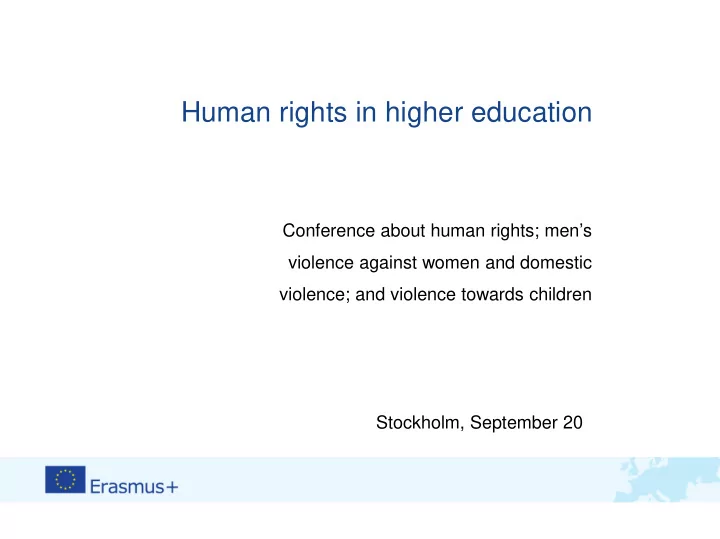

Human rights in higher education Conference about human rights; men’s violence against women and domestic violence; and violence towards children Stockholm, September 20
Contents • About the project • Method of inquiry • Results from the survey • Conclusions
About the project Modernity, education and human rights (MEHR) • Erasmus+ for strategic partnership in higher education • Seven partners (quality assurance agencies, higher education institutions, student union) UKÄ is the coordinator Aims and focus • Strengthening higher education on human rights primarily in professional programmes • Focus on learning outcomes • Focus on quality assurance procedures
Four steps in the project • Step 1: Sweden: A gender perspective on human rights (programmes in social welfare and medicine) • Step 2: Portugal: Migration and intercultural skills and competences for social inclusion (programmes in engineering and geography) • Step 3: Croatia: Citizenship and democratic participation (teacher education programmes) • Step 4: Synthesis presented at conference in Brussels
Step 1: A gender perspective on human rights • Three areas : human rights; men’s violence against women and domestic violence; violence towards children • Programmes included: • All have national qualitative targets ( examensmål ) on human rights • Medical programmes (physician) • Nursing programmes • Occupational therapy programmes • Psychology programmes • Social work programmes
Method of inquiry • Joint venture by UKÄ, KI and ESU • Questionnaire to all higher education institutions with the right to award degrees for the five programmes • 62 programmes were approached and 56 answered the questionnaire (90% response rate) • Seven programmes were self-selected as good examples
Results – is teaching included? • Teaching about human rights – almost always • Teaching about men’s violence against women and domestic violence – 82% • Teaching about violence towards children – 88% • Programmes in occupational therapy stand out (100%, 38%, 50%) • Main reasons for including the three areas are legal requirements, local regulations and teacher competence
Results – learning outcomes (lärandemål) • Human rights – 80% of the programmes have explicit learning outcomes • Men’s violence against women and domestic violence – roughly 40% of the programmes have explicit learning outcomes • Violence towards children – roughly 50% of the programmes have explicit learning outcomes
Why are learning outcomes important? • Transparency – what is expected from students? • Student-centred learning and students’ responsibility for their own learning • Continuity – content in programme determined by learning outcomes, not individual teachers • Constructive alignment – learning outcomes, teaching methods, forms of examination • Ensure that all students have the same knowledge when graduating • Mobility – student and workforce
Results – teaching methods and examination • Teaching is mostly integrated into other courses • Teaching includes both theoretical perspectives and aspects on how to make assessments taking the area into account. • Mainly lectures and seminars • Reading lists most common in human rights • Examination most common in human rights
Mismatch learning outcomes and examination Learning outcomes Examination Human rights: 80% • 87% Men’s violence against women: 41% • 71% Violence towards children: 48% • 70%
Results - teachers • Mostly department’s own teachers • Half of the programmes have teachers with experience as practitioners of the career the programme offers training for • Half of the programmes have teachers that pursue research in human rights • Four out of ten programmes have teachers that pursue research in men’s violence against women and domestic violence • Almost half of the programmes have teachers that pursue research on violence towards children
Results –perspectives Working life perspective • A clear majority maintain a dialogue with professional life in determining learning outcomes Student perspective • A variety of teaching methods and methods of examination are used
Results – development work • Men’s violence against women and domestic violence singled out by 32% of the respondents as an area of development (other two areas to a slightly lesser degree) • Intended learning outcomes and syllabuses • Course literature and examinations • Teacher competence • Increased collaboration with professional life • Increased international collaboration
Conclusions • Although human rights are fairly well covered in the programmes included in the survey there is room for improvement regarding the other two areas • Teaching about human rights is more developed and more formalised than teaching about the other two areas • The mismatch between learning outcomes and examination needs to be addressed by programmes
Recommend
More recommend